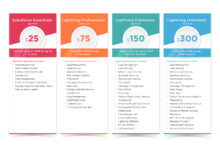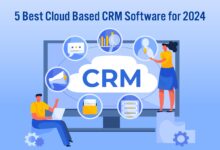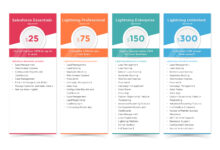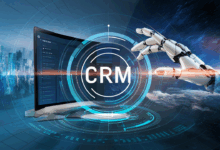CRM Software Cost: Understanding Pricing Models, Scalability, and Hidden Expenses
CRM software cost is a crucial aspect that businesses need to consider when investing in customer relationship management tools. From pricing models to scalability and hidden expenses, this article delves into the various factors that impact the cost of CRM software.
Exploring the intricacies of CRM software pricing can help businesses make informed decisions and optimize their investments in enhancing customer relationships and driving growth.
Factors Determining Mobile App Development Cost
Developing a mobile app involves various factors that directly impact the overall cost. Understanding these key factors is essential for planning and budgeting effectively.
Complexity of Features
The complexity of features integrated into a mobile app significantly influences the development cost. Basic apps with simple functionalities will cost less compared to complex apps requiring advanced features like real-time data synchronization, augmented reality, or AI integration.
Platform Compatibility
Another crucial factor is platform compatibility. Developing an app for multiple platforms such as iOS, Android, and Windows increases the cost due to the need for separate coding, testing, and optimization for each platform. Cross-platform development tools can help reduce costs to some extent.
Design Intricacy
The design intricacy of a mobile app plays a vital role in determining its cost. Custom UI/UX design, animations, and interactive elements add to the development expenses. Simple and minimalistic designs are more cost-effective compared to complex and visually appealing designs.
Maintenance, Updates, and Support Services
Ongoing maintenance, updates, and support services are crucial for the long-term success of a mobile app. Including these services in the development plan impacts the overall cost. Regular updates, bug fixes, security patches, and customer support contribute to the ongoing expenses of maintaining a mobile app.
Types of CRM Software Pricing Models
CRM software pricing models can vary significantly, with different vendors offering per-user, tiered, or flat-rate pricing structures. Each pricing model has its own set of advantages and disadvantages, catering to different business needs and budgets.
Per-User Pricing
- Example: Salesforce offers per-user pricing, where the cost is based on the number of users accessing the software.
- Advantages: Easy to scale for small teams, as you only pay for the users you have. Allows for cost control based on user count.
- Disadvantages: Can become expensive as the organization grows, especially for large companies with many users.
Tiered Pricing
- Example: HubSpot CRM uses tiered pricing, where different features are bundled into various pricing tiers.
- Advantages: Provides flexibility to choose the features that best suit your needs. Cost-effective for organizations with specific requirements.
- Disadvantages: May end up paying for features you don’t need if your requirements fall between tiers.
Flat-Rate Pricing
- Example: Zoho CRM offers flat-rate pricing, where a fixed price is charged regardless of the number of users.
- Advantages: Predictable pricing that is easy to budget for. Suitable for organizations with a stable user base.
- Disadvantages: May not be cost-effective for organizations with fluctuating user numbers or rapid growth.
Analyze the scalability of CRM software pricing
CRM software pricing can be scalable based on factors like the number of users or the size of the organization. As the user base or organization grows, pricing structures may change to accommodate the evolving needs of the business.
Scalability Based on User Count
- When scaling based on user count, some vendors offer volume discounts for larger user numbers.
- As the number of users increases, the overall cost per user may decrease, making it more cost-effective for larger organizations.
Scalability Based on Organization Size
- For organizations with multiple departments or branches, CRM pricing may vary based on the size and complexity of the setup.
- Larger organizations may require custom pricing plans to accommodate their specific needs and scale effectively.
Evaluate the customization options available in CRM software pricing
CRM software vendors offer varying levels of customization in their pricing plans to cater to different business requirements. Customization features can range from basic configurations to advanced integrations, allowing businesses to tailor the CRM system to their specific needs.
Levels of Customization
- Basic customization may include branding options, user permissions, and data fields tailored to the business.
- Advanced customization could involve API integrations, workflow automation, and custom reporting tools.
Impact of Customization on Pricing
- More customization typically leads to higher pricing tiers, reflecting the additional features and functionalities included in the plan.
- Businesses with unique requirements may opt for higher customization levels, even if it means paying a premium for the added flexibility.
Explore additional costs beyond the initial pricing structure
Implementing CRM software may come with additional costs beyond the initial pricing structure, such as hidden fees, add-ons, or integrations. It is essential for businesses to budget and manage these extra costs effectively to avoid unexpected expenses.
Hidden Costs
- Integration fees for connecting the CRM system with other tools or platforms.
- Training costs to onboard employees and ensure effective use of the CRM software.
Add-Ons and Integrations
- Additional charges for premium features, third-party integrations, or specialized modules.
- Costs associated with software updates, maintenance, and customer support beyond the standard package.
Hidden Costs Associated with CRM Software
When investing in CRM software, it’s crucial to consider the hidden costs that may arise during implementation and maintenance. These costs can significantly impact the overall budget and should not be overlooked.
Training and Support
- Training: Providing necessary training for employees to use the CRM system effectively can incur additional costs for onboarding sessions or workshops.
- Support: Ongoing technical support and troubleshooting services may require a subscription or service fee, adding to the long-term cost of CRM software.
Data Migration and Maintenance
- Data Migration: Transferring existing data from legacy systems to the new CRM platform can be complex and costly, especially if data cleansing or customization is required.
- Maintenance: Regular maintenance tasks such as updates, patches, and system optimizations can contribute to the total cost of CRM software ownership over time.
Customization and Integration
Customizing the CRM software to align with specific business processes or integrating it with other systems can lead to additional expenses due to development work or third-party integrations.
Third-Party Plugins and Add-Ons
Some CRM platforms offer third-party plugins or add-ons for extended functionality, but these may come at an extra cost that should be considered in the budgeting process.
Scalability and Upgrades
As businesses grow, the need for additional user licenses, storage capacity, or advanced features may lead to scalability costs and upgrade expenses to accommodate the expanding CRM requirements.
Consulting Services
Engaging consulting services for CRM implementation, configuration, or optimization can influence the overall cost, as these services often come with professional fees based on the scope of work involved.
Cost-Benefit Analysis of CRM Software
Implementing CRM software can have a significant impact on an organization’s operations and bottom line. Conducting a cost-benefit analysis is crucial to determine whether the investment in CRM software is justified and to understand the potential returns.
Step-by-Step Process of Conducting a Cost-Benefit Analysis
- Identify Costs: Start by listing all the costs associated with implementing and maintaining the CRM software, including initial setup costs, licensing fees, training expenses, and ongoing support costs.
- Estimate Benefits: Next, estimate the potential benefits of CRM software, such as increased sales revenue, improved customer retention, reduced marketing costs, and enhanced operational efficiency.
- Compare Costs and Benefits: Evaluate the costs against the benefits to determine whether the benefits outweigh the costs and if the investment is financially viable.
Tangible and Intangible Benefits of CRM Software
Organizations can expect both tangible and intangible benefits from implementing CRM software:
- Tangible Benefits: Increased sales revenue, reduced marketing costs, cost savings on customer service, and improved operational efficiency.
- Intangible Benefits: Improved customer satisfaction, enhanced brand loyalty, better customer relationships, and streamlined processes.
Quantifying Return on Investment (ROI) of CRM Software
There are several methods and metrics to quantify the ROI of CRM software:
- Payback Period: The time it takes for the benefits to equal the costs.
- Net Present Value (NPV): The difference between the present value of cash inflows and outflows over a specified period.
- Internal Rate of Return (IRR): The discount rate that makes the net present value of all cash flows from a particular project equal to zero.
| Costs | Benefits |
|---|---|
| Initial Investment | Increased Sales Revenue |
| Recurring Costs | Reduced Marketing Costs |
| Ongoing Support | Improved Customer Retention |
Organizations can factor in qualitative benefits like enhanced customer relationships and streamlined processes into the cost-benefit analysis to provide a more comprehensive evaluation.
Customization Options and Cost Implications
When it comes to CRM software, customization plays a crucial role in meeting the specific needs of a business. However, it is important to understand how customization can affect the overall cost of implementing and maintaining CRM software.
Customization can have both positive and negative cost implications. On the one hand, tailoring CRM software to align with the unique processes and requirements of a business can lead to increased efficiency, productivity, and user adoption. On the other hand, customization often requires additional development work, specialized expertise, and ongoing support, which can result in higher upfront and recurring costs.
Benefits of Customization
Customizing CRM software allows businesses to optimize their workflows, automate repetitive tasks, and improve customer engagement. By tailoring the software to specific business needs, companies can enhance data management, reporting capabilities, and overall customer satisfaction. While customization may incur additional costs, the benefits of a tailored CRM solution often outweigh the expenses in the long run.
- Integration with existing systems: Many CRM software providers offer customization options to integrate the CRM system with other business applications and tools. This ensures seamless data flow and improved collaboration across departments. However, integration features may come at an extra cost depending on the complexity of the integration.
- Personalized dashboards and reports: Customizing dashboards and reports allows users to access relevant data quickly and make informed decisions. Businesses can choose specific metrics, KPIs, and visualizations to create customized reports tailored to their unique requirements. While this level of customization enhances data visibility and analysis, it may require additional development work and incur extra costs.
- Workflow automation: Customizing workflows within CRM software streamlines processes, reduces manual errors, and increases operational efficiency. Businesses can automate tasks such as lead scoring, email notifications, and follow-up reminders to ensure timely and personalized interactions with customers. While workflow automation can optimize business processes, it may involve customization costs for workflow design and implementation.
Negotiating CRM Software Costs
When it comes to negotiating CRM software costs, there are several strategies that can help you get the best deal possible. Understanding pricing structures and contract terms before entering negotiations is crucial to ensure you are well-informed and prepared. By following these tips, you can increase your chances of securing discounts, special offers, or flexible payment terms when purchasing CRM software.
Importance of Understanding Pricing Structures
Understanding the pricing structures offered by CRM software vendors is essential before negotiating. Take the time to review different pricing models and identify which one aligns best with your business needs and budget. This knowledge will empower you to negotiate effectively and avoid unexpected costs down the line.
- Research and compare pricing models offered by different CRM software vendors.
- Identify the features and services included in each pricing tier to determine the best value for your business.
- Consider the scalability of the pricing model to ensure it can accommodate your future growth.
Strategies for Negotiating Pricing
When negotiating with CRM software vendors, consider the following strategies to help you secure the best possible deal:
- Highlight your business’s unique needs and requirements to negotiate a customized pricing plan.
- Bundle services or features to leverage discounts and added value from the vendor.
- Negotiate for flexible payment terms or extended trial periods to test the software before committing.
Securing Discounts and Special Offers
Vendors may be willing to offer discounts or special promotions to win your business. Here are some tips to help you secure these benefits:
- Ask for volume discounts if you are purchasing multiple licenses or require additional services.
- Look for promotional offers or seasonal discounts that vendors may be running.
- Consider negotiating for free training or implementation services to offset costs.
Total Cost of Ownership (TCO) for CRM Software
Understanding the Total Cost of Ownership (TCO) for CRM software is essential for organizations looking to make informed decisions about their investments. TCO goes beyond the initial purchase price and includes all costs associated with implementing, operating, and maintaining the CRM software over its entire lifecycle.
Key Cost Components in Calculating TCO
- Licensing fees
- Implementation costs
- Training expenses
- Integration costs with existing systems
- Customization and ongoing support costs
- Hardware and infrastructure expenses
Importance of TCO Analysis
TCO analysis helps organizations evaluate the true cost of CRM software solutions and compare different options effectively. By considering all direct and indirect costs associated with CRM software, businesses can make more accurate budget forecasts and choose a solution that aligns with their long-term goals.
Conducting TCO Analysis
- Identify all cost components
- Estimate costs for each component
- Calculate the total cost over the software’s lifecycle
- Compare TCO of different CRM software options
Indirect Costs to Consider
- Lost productivity during implementation
- Downtime and disruptions to business operations
- Data migration and cleanup expenses
- Opportunity costs of delayed decision-making
Comparing TCO of Different CRM Software Options
For example, when comparing a cloud-based CRM solution with an on-premise one, the TCO analysis would consider factors such as maintenance costs, scalability, and security. The analysis can help organizations choose the option that provides the most value and aligns with their budget constraints.
Factors Influencing Price Discrepancies Among CRM Software Providers
In the competitive landscape of CRM software, pricing variations among different providers can be influenced by several key factors. Let’s delve into the aspects that drive these price differences and understand how they impact the overall cost for businesses.
Brand Reputation and Pricing
The reputation of a CRM software vendor in the industry can significantly affect pricing decisions. Established and well-known brands may command higher prices due to their perceived reliability and trustworthiness. On the other hand, newer or lesser-known providers might offer more competitive pricing to attract customers.
Features and Pricing Structures
The level of features offered in CRM software can directly impact pricing structures. Providers offering advanced functionalities, customization options, and integrations may charge higher prices compared to basic CRM solutions with limited features. Businesses need to assess their specific requirements and choose a software package that aligns with their needs and budget.
Customer Support Services and Price Discrepancies
Differences in customer support services can also lead to price variations among CRM software providers. Companies that offer round-the-clock support, dedicated account managers, and comprehensive training programs may charge premium prices for their services. In contrast, providers with limited support options may offer more budget-friendly solutions.
Market Competition and Pricing Strategies
Market competition plays a crucial role in determining the pricing strategies of CRM software vendors. In a crowded marketplace, providers may adjust their prices to stay competitive and attract new customers. Price wars, discounts, and promotional offers are common tactics used by vendors to differentiate themselves and gain market share.
Target Market Demographics and Pricing Flexibility
The target market demographics, industry verticals, and customer segments served by CRM software providers can also influence pricing decisions. Providers catering to niche industries or specific customer segments may tailor their pricing plans to meet the unique needs of their target audience. This segmentation can result in price variations based on the value proposition offered to different market segments.
Cost-Efficient Alternatives to Traditional CRM Software
When looking for cost-efficient alternatives to traditional CRM software, organizations often consider options like open-source CRM software or cloud-based CRM platforms. These alternatives can offer significant cost savings compared to traditional proprietary CRM solutions.
Open-Source CRM Software
- Open-source CRM software is free to use and can be customized to suit the specific needs of an organization.
- One of the key benefits is the flexibility it offers in terms of customization without the high costs associated with proprietary software.
- However, organizations need to invest in technical resources to manage and maintain the software, which can incur additional costs.
Cloud-Based CRM Platforms
- Cloud-based CRM platforms offer a pay-as-you-go pricing model, eliminating the need for large upfront investments.
- These platforms are scalable, allowing organizations to adjust their usage and costs based on their needs.
- Integration with other cloud services and ease of access from anywhere are additional benefits of cloud-based CRM platforms.
Case Studies
- Company X successfully implemented open-source CRM software, reducing their CRM software costs by 50% while maintaining the required functionalities.
- Organization Y opted for a cloud-based CRM platform, resulting in a 30% reduction in their overall CRM expenses due to the flexible pricing structure.
Budgeting and Financial Planning for CRM Software Implementation
Budgeting and financial planning are crucial aspects to consider when implementing CRM software. It ensures that the organization has a clear understanding of the costs involved and can allocate resources effectively to maximize the benefits of the CRM system.
Creating a Budget for CRM Software Acquisition, Deployment, and Maintenance
Creating a budget for CRM software involves several key steps:
- Identify the specific needs and requirements of the organization.
- Research and compare different CRM software options to determine the most suitable solution.
- Estimate the upfront costs of acquiring the software, including licensing fees, implementation costs, and any customization or integration expenses.
- Consider ongoing maintenance and support costs, such as subscription fees, training, and updates.
- Factor in additional expenses, such as hardware upgrades, data migration, and potential consulting services.
Aligning CRM Software Costs with Financial Goals and Business Objectives
It is essential to align CRM software costs with the organization’s financial goals and business objectives to ensure a positive return on investment. Best practices include:
- Setting clear objectives and KPIs to measure the impact of the CRM system on business performance.
- Regularly monitoring and evaluating the costs and benefits of the CRM software to make informed decisions.
- Involving key stakeholders in the budgeting process to gain buy-in and support for the CRM implementation.
- Continuously optimizing the use of CRM software to maximize its value and efficiency.
Cost Comparison of On-Premise vs. Cloud-Based CRM Software
When considering a CRM software solution, one crucial decision is choosing between on-premise and cloud-based deployment. Each option comes with its own set of costs and benefits that can significantly impact a company’s bottom line.
On-Premise CRM Software:
Factors Affecting Cost
- Upfront Expenses: On-premise CRM software typically requires a significant upfront investment in hardware, software licenses, and implementation.
- Ongoing Maintenance: Companies need to budget for ongoing maintenance costs, including IT staff salaries, updates, and upgrades.
- Scalability: Scaling an on-premise CRM system can be complex and costly, as it may involve purchasing additional hardware and software licenses.
- Security: While on-premise solutions offer greater control over data security, they also require investments in security measures and compliance.
Cloud-Based CRM Software:
Factors Affecting Cost
- Subscription Model: Cloud-based CRM solutions operate on a subscription basis, eliminating the need for large upfront expenditures.
- Ongoing Costs: Companies pay a monthly or annual fee for cloud-based CRM, which often includes maintenance, updates, and support services.
- Scalability: Cloud-based solutions are easily scalable, allowing companies to adjust their subscription plans as needed without significant additional costs.
- Security: Cloud providers invest heavily in security measures, but companies must ensure compliance with data protection regulations.
Based on these factors, organizations with limited capital and a preference for flexibility may find cloud-based CRM software to be more cost-effective. Conversely, businesses with strict security requirements and a focus on data control may opt for the higher upfront costs of on-premise solutions. It’s essential to evaluate the specific needs and priorities of your organization when choosing between these two deployment options.
Factors Impacting CRM Software Renewal Costs
When it comes to renewing CRM software licenses or subscriptions, several factors can influence the costs involved. Understanding these factors is crucial for optimizing renewal expenses and negotiating favorable terms with CRM software providers.
Vendor Relationships
Maintaining strong vendor relationships can play a significant role in influencing CRM software renewal costs. Companies that have a positive and collaborative relationship with their CRM software providers may have more flexibility in negotiating renewal terms, potentially leading to cost savings.
Service Level Agreements (SLAs)
The terms outlined in service level agreements (SLAs) can impact CRM software renewal costs. Companies with SLAs that include guarantees for software performance, uptime, and support levels may see higher renewal costs compared to those with more basic SLAs. It’s essential to review and negotiate SLAs to ensure they align with your organization’s needs and budget.
Software Updates and Additional Modules
The inclusion of software updates and additional modules in CRM software renewal packages can also affect costs. Companies that require frequent updates or access to advanced features through add-on modules may incur higher renewal expenses. Understanding the necessity of these updates and modules can help in controlling renewal costs effectively.
Optimizing Renewal Costs
To optimize CRM software renewal costs, companies can consider strategies such as conducting a thorough review of their current usage and needs, negotiating with vendors based on their relationship and service requirements, and exploring alternative pricing models that offer cost savings. By leveraging these strategies, organizations can better manage their CRM software renewal expenses and ensure they are getting the most value out of their investment.
Cost Allocation for CRM Software Across Departments
In organizations, allocating CRM software costs across different departments is crucial for fair distribution and accountability. It ensures that each department pays for the resources they use and the benefits they receive from the software. However, this process can be challenging due to varying usage levels, perceived benefits, and departmental needs.
Methods of Cost Allocation for CRM Software
- Fixed Costs: This method involves dividing the total cost of CRM software equally among all departments, regardless of their usage or benefits. It provides simplicity and predictability in budgeting but may lead to unfairness if some departments use the software more than others.
- Usage-Based Costs: Allocating costs based on the actual usage of CRM software by each department. This ensures that departments pay according to their usage levels, promoting cost efficiency. However, tracking usage accurately can be challenging.
- Benefits-Driven Costs: This approach links the cost allocation to the perceived benefits each department receives from the CRM software. It aligns costs with value generation but can be subjective and difficult to quantify objectively.
Transparent cost allocation practices are essential to ensure fair distribution and accountability across departments.
Scenario: Cost Allocation for New CRM Software Implementation
When a company implements a new CRM software, the steps involved in determining cost allocation for each department include:
- Assessing the needs and expected benefits of CRM software for each department.
- Estimating the total cost of CRM software and associated expenses.
- Deciding on a suitable cost allocation method based on usage, benefits, or fixed costs.
- Communicating the cost allocation plan transparently to all departments for buy-in and accountability.
Case Study: A company faced challenges in cost allocation for CRM software due to varying usage levels across departments. To resolve this, they implemented a usage-based cost allocation method, which led to more equitable distribution and cost efficiency.
Cost Saving Strategies for CRM Software Implementation
Implementing CRM software can be a significant investment for organizations. However, there are ways to optimize the implementation process and reduce unnecessary expenses while maximizing the value of the software. Here are some cost-saving strategies to consider:
Leveraging Open-Source CRM Software
Using open-source CRM software can be a cost-effective alternative to commercial solutions. These platforms often have robust features and functionalities comparable to paid options, making them a viable choice for organizations looking to save on software costs.
Conducting a Cost Analysis
Before implementing CRM software, conducting a thorough cost analysis can help identify areas where expenses can be minimized. This analysis should include evaluating the organization’s current processes, identifying inefficiencies, and determining the features and functionalities needed from the CRM software.
Integrating with Existing Technology Infrastructure
Leveraging existing technology infrastructure can help integrate CRM software seamlessly and cost-effectively. By utilizing compatible systems and tools already in place within the organization, costs associated with software integration and customization can be reduced.
Comparing Costs Across Different Providers
It’s essential to compare the costs associated with different CRM software providers and the features they offer. Creating a comparison table can help organizations make informed decisions based on their budget and requirements, ensuring they choose a cost-effective solution that meets their needs.
Case Study: Successful Cost-Saving Strategies
A case study demonstrating successful cost-saving strategies implemented during a CRM software deployment can provide valuable insights for other organizations. By showcasing real-life examples of how cost efficiencies were achieved, businesses can learn from best practices and apply them to their own CRM implementations.
Future Trends in CRM Software Cost Management
In the ever-evolving landscape of CRM software, staying ahead of future trends in cost management is crucial for organizations looking to optimize their investments. Advancements in technology, changes in pricing models, and shifts in competitive dynamics are shaping the future of CRM software costs.
Shift Towards Subscription-Based Pricing
With the rise of cloud-based solutions, many CRM software providers are moving towards subscription-based pricing models. This trend allows organizations to pay for software on a recurring basis, often monthly or annually, rather than making a large upfront investment. Subscription models provide greater flexibility and scalability, enabling companies to adjust their CRM usage based on changing needs.
- Subscription-based pricing offers cost predictability and eliminates the need for significant upfront capital expenditures.
- Organizations can easily scale their CRM usage up or down depending on business requirements, leading to more efficient cost management.
- However, it’s essential for companies to closely monitor subscription costs and usage to avoid overspending on unnecessary features or licenses.
Integration of AI and Automation
The integration of artificial intelligence (AI) and automation functionalities into CRM software is a growing trend that can impact costs. AI-powered tools can streamline processes, enhance customer interactions, and provide valuable insights for decision-making. While AI implementation may initially require investment, the long-term cost savings and efficiency gains can be significant.
- AI and automation can reduce manual tasks, improve data accuracy, and enhance productivity, ultimately driving cost efficiencies.
- Organizations that leverage AI capabilities in CRM software may experience lower operational costs and improved customer satisfaction.
- However, it’s essential to carefully assess the ROI of AI integration to ensure that the benefits outweigh the initial investment costs.
Focus on Personalization and Customer Experience
As customer expectations continue to rise, CRM software providers are placing a greater emphasis on personalization and enhancing the overall customer experience. Tailoring CRM solutions to meet specific business needs and delivering personalized interactions can drive customer loyalty and retention. While customization and personalization features can add value, they may also impact costs depending on the level of complexity and implementation required.
- Investing in personalized customer experiences through CRM software can lead to higher customer satisfaction and increased revenue opportunities.
- Organizations should weigh the cost implications of customization against the potential benefits in terms of customer engagement and retention.
- Striking a balance between personalization and cost-effectiveness will be essential for organizations looking to maximize the value of their CRM investments.
Final Thoughts
By understanding the complexities of CRM software cost and the different variables that influence pricing, businesses can effectively manage their budgets and maximize the value derived from their CRM systems. Navigating the world of CRM software pricing can lead to strategic decisions that align with business objectives and customer needs.




